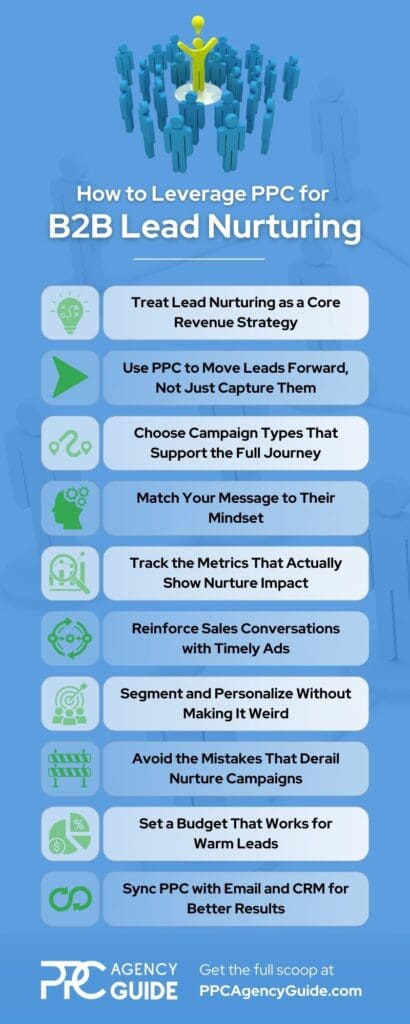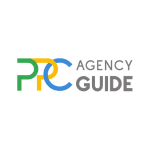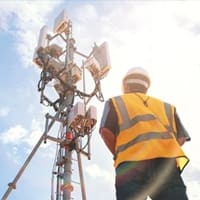
Did you know that 80 percent of new leads never become closed deals, per Zendesk? The odds are stacked against you. But we know that companies that do well with lead nurturing have a strong advantage. They generate 50 percent more sales-ready leads and spend 33 percent less, according to Business News Daily. Despite this, just 35 percent of marketers have implemented lead nurturing processes, Sender reports. The good news is that this is an easy fix, and you can work nurturing into the very same channels you’re already leveraging. In this guide, we’ll explore using PPC for B2B nurturing, so you can get started quickly and streamline your strategy.
Treat Lead Nurturing as a Core Revenue Strategy
Businesses often focus exclusively on lead generation, expecting to meet a lead and close the sale right away. In reality, roughly 60 percent of B2B companies say it takes over a month to close a deal, according to databox. Around a quarter say it takes over three months. And, the bigger the deal, the longer it takes to close it.
Buyers Are Still Making Decisions During the Waiting Game
Your lead is not watching the clock tick with a decision already made during this time. They’re exploring options, researching alternatives, and likely talking to your competitors. If you aren’t keeping your solution top of mind during this phase, you’re losing them.
Nurturing Shortens Sales Cycles and Increases Deal Size
On the flip side, we know that you can shorten this cycle by 23 percent when you nurture, per Salesgenie data. And, you’ll also see order values that are 47 percent higher. If you’re serious about growing your revenue, you need to be serious about lead nurturing with PPC, too.

Use PPC to Move Leads Forward, Not Just Capture Them
Once a prospect enters your funnel, they still have a long road ahead. PPC gives you a way to stay present and helpful throughout the decision-making process, especially when sales conversations pause or leads go quiet.
Reconnect with Leads Between Sales Touchpoints
There’s often a delay between when someone expresses interest and when they’re ready to move forward. Paid campaigns let you bridge that gap.
- Share Case Studies and Testimonials: Reinforce credibility while your sales team waits on a response.
- Promote Educational Content: Help hesitant leads justify the investment with ROI calculators, buying guides, or comparison sheets.
- Deliver Light Reminders: Subtle ads pointing back to your demo page, pricing guide, or earlier downloads can bring the conversation back to life.
Reach the Entire Buying Committee
Your original contact might be sold, but rarely are they the only one involved in the decision.
- Tailor B2B PPC Ads by Role: Use LinkedIn or Display targeting to speak directly to technical, financial, or operational stakeholders.
- Support Account-Based Strategies: Upload company or lead lists to show coordinated messaging across roles.
- Focus on Organizational Needs: Reinforce value from multiple angles so momentum builds across the team.
Let PPC Fill the Gaps in Your Nurture Strategy
Even the best nurture emails get ignored. PPC ensures you’re still present without overwhelming the prospect.
- Stay Top of Mind Without Pressure: Passive exposure through ads reinforces brand recall while respecting boundaries.
- Trigger Ads Based on Engagement: Create workflows that respond to behaviors like attending webinars or revisiting key pages.
- Back Up Sales with Consistent Messaging: When leads see the same value props in emails, calls, and ads, your brand feels more credible.
Choose Campaign Types That Support the Full Journey
PPC gives you a set of powerful tools to keep the conversation going. However, the formats and PPC targeting options will be different from what you’re accustomed to in lead generation ads.
Remarketing Campaigns Keep You Relevant Without Pushing
You can use remarketing and retargeting for B2B PPC campaigns to re-engage people who have already interacted with your brand, such as by visiting a pricing page, downloading content, or simply lingering on your site.
- Use Sequential Messaging: Adjust creative and offers based on how recently and how deeply the lead engaged.
- Reengage Leads Who Drop Off: Set time-based windows to recapture attention if a lead goes quiet.
- Deliver Reminders without Clutter: Subtle reminders to revisit your demo page or complete a sign-up can help leads pick up where they left off.
Customer Match and Matched Audiences Enable Personalization at Scale
With Customer Match in Google Ads or Matched Audiences on LinkedIn, you can upload your existing lead list and serve targeted ads to known contacts.
- Segment Lists by Funnel Stage or Action: Tailor ads to demo requesters, marketing qualified leads (MQLs), or specific campaign responders.
- Run “Supportive” Messaging That Echoes Sales Conversations: Reinforce proposals, key benefits, or value differentiators that align with current sales interactions.
- Coordinate with Sales Activity: Align campaign triggers with CRM updates, such as proposal sent, follow-up requested, or contract review underway.
Lookalike and Similar Audiences Can Strengthen Mid-Funnel Coverage
While not traditional nurturing tools, lookalike audiences can supplement your mid-funnel campaigns when used carefully.
- Use as a Layer for Broadening Reach within Target Accounts: Target others at the same company or similar companies, especially when decision-making involves multiple people.
- Avoid Using for Top-of-Funnel Cold Outreach: Keep messaging aligned with nurturing goals, not general awareness.
- Focus on Expansion within Warm Segments: Use engagement filters to make sure you’re not pushing introductory messaging to unknown contacts.
Match Your Message to Their Mindset
Once you reach the nurturing stage, you should be focusing on reinforcing value, addressing concerns, and helping decision-makers feel confident taking the next step. Crafting the right kind of ad copy for B2B lead nurturing is critical to your success.
The mistake many businesses make is serving the same message to everyone, regardless of where they are in the buying process. But someone who just downloaded a whitepaper doesn’t need a hard push toward a contract, and someone reviewing a proposal doesn’t need a reminder of your top-level features.
When your messaging aligns with intent, leads feel understood. And that’s what moves them forward.
Map Messaging to Buyer Readiness
At this stage, some leads are still evaluating, comparing, or just learning. Tailoring your message to meet them where they are improves engagement and builds trust.
- Use Educational Content for PPC Leads in Research Mode: These leads benefit from product comparison guides, use case examples, or explainer videos.
- Reinforce ROI for Leads Closer to a Decision: Share data-driven case studies, pricing insights, and short testimonials that show real-world results.
- Support Sales Conversations with Contextual Ads: If a lead recently viewed your demo or pricing page, your ads should pick up where that interest left off.
Avoid Sending Mixed Signals
Consistency is key when you’re nurturing. If your lead just had a discovery call and then sees a generic awareness ad the next day, it creates confusion and erodes trust.
- Align Ad Messaging with Sales Follow-Ups: Mirror the tone and substance of your most recent outreach.
- Stay Focused on One Objective Per Ad: Trying to educate, convert, and book a call in one ad usually results in none of the above.
- Use Landing Pages That Match the Message: Don’t break the flow by sending a mid-funnel lead to a cold, generic homepage. Use a tailored landing page instead.
Track the Metrics That Actually Show Nurture Impact
You’ll miss the bigger picture if you’re judging nurture campaigns by how many conversions they directly produce. Most leads won’t convert off a single touchpoint. Instead, when tracking B2B PPC performance metrics, focus on indicators that show how your campaigns are contributing to pipeline momentum.
Look Beyond Last-Click Attribution
Nurture campaigns often play a supporting role. That doesn’t make them less valuable. It just means their influence is more subtle.
- Track Assisted Conversions: See how often your PPC campaigns contribute to deals, even if they’re not the final step before conversion.
- Monitor Multi-Touch Journeys: Use analytics tools that capture how leads engage with your content across platforms and over time.
- Use View-Through Conversions (When Applicable): Especially useful in display and video campaigns, these can show when someone sees an ad and returns later to take action.
Pay Attention to Engagement Quality
In a nurturing context, you care more about what happens after the click.
- Measure Time on Site and Pages per Visit: These signal genuine interest and deeper exploration.
- Track Return Visits from Known Leads: When someone keeps coming back, it’s usually a sign they’re moving closer to a decision.
- Watch for Shifts in Behavior: If a lead moves from blog content to pricing or demo pages, that signals forward motion.
Align Metrics with Sales Outcomes
Marketing KPIs are only useful if they tie back to revenue. Your PPC reporting should connect the dots.
- Map Campaigns to CRM Stages: Set up tracking to show how ads influence movement from one deal stage to the next.
- Collaborate with Sales on Attribution: If a proposal closed after a nurture campaign, make sure that insight is captured, even if the ad didn’t trigger the final click.
- Track Sales Cycle Length and Deal Size for Nurtured Leads: These are often the clearest indicators that your efforts are paying off.
Reinforce Sales Conversations with Timely Ads
When a prospect is in contact with your team, PPC helps reinforce key points, rebuild momentum, and keep your brand top of mind between touchpoints.
When someone is actively considering your solution, even a small distraction, such as a competing offer, internal delay, or a lost email, can derail progress. Timely, well-placed ads can help anchor their attention and move the deal forward.
Echo Key Messages from Sales Calls
Consistency across channels builds trust. If your rep just shared a case study or outlined pricing, your ads can back that up visually.
- Reinforce Core Differentiators: Use ads to highlight the same value props shared in the sales conversation.
- Share Proof Points at the Right Moment: Case studies, testimonials, and ROI stats have more impact when they mirror the conversation already happening.
- Tailor Messaging by Sales Stage: Someone reviewing a contract needs different messaging than someone still gathering initial information.
Use Campaign Timing to Stay Present without Pressure
Sales teams spend much of their time waiting on replies. PPC gives you a way to stay visible without adding more asks.
- Trigger Ads Based on Funnel Milestones: If a proposal was sent or a discovery call completed, use that to initiate a new ad sequence.
- Support Multi-Channel Follow-Up: Your ads should complement sales emails and voicemails, not compete with them.
- Stay Top of Mind During Lulls: If the deal is quiet for a week, a reminder ad can help reengage interest without chasing.

Coordinate Between Sales and Marketing
This kind of reinforcement only works if sales and marketing are in sync. Your campaigns need to reflect what’s actually happening in the pipeline.
- Use CRM Signals to Drive Campaign Logic: Integrate with platforms like HubSpot or Salesforce to trigger campaigns based on deal activity.
- Get Input from Reps on Messaging: Ask what questions leads are asking, and use that insight to inform ad creative.
- Make Feedback Loops Easy: When a deal closes (or stalls), your team should know what messages were seen and which ones landed.
Segment and Personalize without Making it Weird
Personalization is one of the most effective ways to improve engagement, but it has to feel natural. In a B2B context, that means showing leads content that’s relevant to their role, industry, or behavior without making it feel like you’re tracking their every move.
Getting this right starts with audience segmentation in B2B PPC. When your audience lists are structured well, personalization becomes useful instead of uncomfortable.
Build Segments That Reflect Buyer Context
One of the fastest ways to improve PPC performance is to stop sending the same message to every lead.
- Segment by Funnel Stage: Someone who recently downloaded a whitepaper needs different messaging than someone who’s reviewing a proposal.
- Segment by Job Role or Department: A CFO might care about ROI or cost control, while a department lead is focused on usability or workflow integration
- Segment by Behavior: If a lead visited your pricing page, show ads that address cost justification. If they watched a product video, follow up with implementation tips.
Use Personalization to Add Value, Not Pressure
Effective personalization highlights relevance. Poor personalization feels invasive. The difference usually comes down to tone and timing.
- Speak to the Problem, Not the Person: You don’t need to call someone by name or reference their exact company to show you understand their challenge.
- Offer Helpful Next Steps Based on What They’ve Done: If someone downloaded an industry guide, invite them to a related webinar or offer a checklist that helps apply the insight.
- Avoid Overuse of Dynamic Insertion: Personalizing an ad headline with a company name doesn’t impress most B2B buyers, it often feels like a gimmick.
Give Your Messaging Room to Breathe
Just because you can personalize everything doesn’t mean you should. In many cases, it’s more effective to focus on being clear, relevant, and timely.
- Lead with Insight, Not Intrusion: Sharing trends, benchmarks, or how similar companies solved a problem is often more persuasive than calling out individual behaviors.
- Let the Landing Page Do the Heavy Lifting: Ads should get attention. Landing pages can handle the deeper personalization, especially when integrated with your CRM or marketing automation tools.
- Keep the User Experience in Mind: Over-segmentation can create inconsistent journeys. Make sure every version of your message still leads to a coherent next step.
Avoid the Mistakes That Derail Nurture Campaigns
Nurture campaigns often fail quietly; not because they’re off-target, but because they’re misaligned, mistimed, or measured incorrectly. These issues can be easy to overlook, especially when your focus is spread across multiple marketing channels.
If your PPC efforts aren’t helping move leads closer to a decision, it’s worth taking a step back and looking for common missteps.
Sending One Message to Every Lead
Lack of segmentation limits relevance. If every lead gets the same ad, your message will feel generic, even if it’s technically accurate. Leads respond better when messaging reflects where they are in the process and what they care about most.
Over-Reliance on Last-Click Metrics
Misleading attribution masks impact. Nurture campaigns often influence deals indirectly. If you’re only crediting the last ad clicked before a conversion, you’re likely undervaluing the earlier touchpoints that helped build trust.
Pushing for the Sale Too Early
Misaligned CTAs push leads away. Not every prospect is ready to “Book a Demo” or “Talk to Sales.” If your ads skip the learning phase and push too hard, too soon, leads may disengage instead of moving forward.
Failing to Align with Sales Activity
Disconnected messaging breaks momentum. If your ads don’t reflect what’s happening in the sales process, like a recent proposal, meeting, or call, leads may feel like your outreach is out of sync or tone-deaf.
Neglecting Landing Page Optimization
Inconsistent journeys create drop-off. Even a well-crafted ad can fall flat if the landing page feels irrelevant, overly generic, or disconnected from what the lead expected to see.
Set a Budget That Works for Warm Leads
Most businesses set aside the bulk of their PPC budget for lead generation. That’s understandable. Net new leads are easy to measure, and results tend to show up fast. But if you stop investing once a lead enters the funnel, you’re relying on sales and email to do all the heavy lifting.
Nurture campaigns don’t need to dominate your ad budget, but they do need a consistent slice of it, and they need to be measured differently.
Budget for Progress, Not Volume
Nurture campaigns are less about generating clicks and more about moving deals forward. It’s different than how you might handle traditional budget management in B2B PPC.
- Expect Lower Click Volume with Higher Value: Warm-lead audiences are smaller by nature, but the returns can be much larger when they convert.
- Shift Some Budget from Cold Audiences: If you’re seeing leads pile up but not convert, reallocating spend to nurture campaigns can help close the gap
- Invest in the Middle of the Funnel: Don’t wait until a lead goes dark to re-engage. Proactive nurturing keeps momentum up and reduces drop-off.
Use Campaign Goals to Inform Spend
Nurture campaigns will require differing budgets. Your goals should drive how much you spend and how long you run the campaign.
- Support Sales-Driven Milestones: If you have a big push around proposals or contract closes, consider increasing spend temporarily to back those efforts.
- Run Always-On Campaigns for Key Segments: For leads who haven’t yet engaged with sales or have stalled, keep messaging live year-round.
- Test and Optimize in Smaller Batches: Because these audiences are smaller, it’s often smarter to test quietly, optimize creative, and then scale.
Sync PPC with Email and CRM for Better Results
When PPC operates in a silo, you miss opportunities to reinforce your message, personalize your campaigns, and support sales activity at exactly the right time. But when PPC works alongside your email marketing and CRM, your nurturing becomes far more effective and measurable.
The data you already have about your leads can and should shape your ad campaigns. And in return, your ads can support and amplify every email, call, and sales conversation.
Use CRM Data to Trigger Smarter Campaigns
Your CRM holds the context you need to target leads more precisely, like what pages they’ve visited, which emails they’ve opened, and what stage of the funnel they’re in.
- Target Leads Based on Sales Stage: Adjust messaging depending on whether someone is post-demo, awaiting a proposal, or re-engaging after a stall.
- Build Campaigns That Reflect Sales Activity: Sync your campaigns with pipeline updates so ads evolve alongside the deal.
- Ensure Consistent Messaging Across Channels: Leads should hear the same message in your emails, ads, and calls, not a disjointed mix.
Let Email and PPC Work Together
Email gives you a direct line to leads, but inboxes are crowded, and open rates are never guaranteed. PPC helps you stay present when emails get missed or ignored.
- Reinforce Email Messaging with Ad Campaigns: If you send a follow-up with a link to a case study or invite to a webinar, your ads can echo that message in parallel.
- Use Ad Campaigns to Reactivate Inactive Email Leads: If someone hasn’t opened your emails in a while, targeted ads can help re-engage them in a less intrusive way.
- Time PPC to Back Major Email Campaigns: If you’re running a lead nurture sequence, mirror the cadence in your ad strategy for added impact.
Improve Sales Outcomes with Better Data Alignment
The more tightly your CRM and PPC platforms are connected, the more visibility you have into what’s working, and the more your team can act on it.
- Use Campaign Data to Inform Sales Conversations: If a lead just clicked on an ad about pricing or viewed your testimonials, your sales team should know.
- Feed Ad Engagement Back into Your CRM: This lets you score leads more accurately and prioritize outreach based on actual interest.
- Leverage CRM-Powered Retargeting: Platforms like Google and LinkedIn allow you to upload segmented lead lists, direct from your CRM, and target them with messaging tailored to the pipeline stage.
And here’s where it all ties together: using a CRM can help increase sales by up to 29 percent, according to Zendesk. When your PPC strategy pulls from that same data and feeds insights back into it, you create a cycle that improves lead quality, shortens sales cycles, and boosts close rates.
Get Expert Help Creating B2B PPC Campaigns
B2B lead generation and nurturing campaigns are complicated. Cycles are long, more people are involved in the buying process, and you need to maintain consistency while meeting the right person with the right message at the right time. But, when you get it right, you close more deals and boost revenue. An experienced PPC agency can help ensure you hit that mark quickly. To be matched with an agency that’s skilled in strategies for B2B lead generation and nurturing, request a complimentary consultation.
FAQs on How to Leverage PPC for B2B Lead Nurturing
How do I generate leads with PPC in B2B?
PPC lead generation in B2B works best when campaigns are tailored to the buyer’s intent and supported by useful content, not just contact forms. Focus on value, not volume.
What’s the best way to measure ROI from B2B PPC?
Measuring ROI of B2B PPC campaigns requires tracking influence across the funnel, not just last-click conversions. Look at assisted conversions, sales cycle velocity, and pipeline impact.
How do I tailor ads for B2B audiences?
Optimizing PPC for B2B audiences means aligning ad messaging with job roles, funnel stage, and deal complexity. Use platform tools to segment and personalize without overcomplicating the journey.
How does PPC help with B2B lead nurturing?
PPC helps keep your brand visible between sales touchpoints. By showing targeted ads to warm leads, you can reinforce key messages, build trust, and guide decision-making without relying solely on email or sales outreach.
What types of PPC campaigns are best for lead nurturing?
Remarketing, Customer Match, and LinkedIn Matched Audiences are ideal for nurturing. These campaign types let you reach leads who’ve already engaged and deliver messaging that aligns with their current stage in the buying process.
When should I start nurturing a PPC lead?
Start as soon as a lead takes a meaningful action, like downloading gated content or attending a webinar. Waiting too long increases the risk of drop-off. Nurture campaigns help maintain momentum and guide the next step.
Can PPC shorten the B2B sales cycle?
Yes. Targeted nurture campaigns can reduce the sales cycle by keeping your solution top of mind and addressing objections early. Data shows nurturing can shorten close time by more than twenty percent.
How do I know if my nurture campaigns are working?
Look beyond clicks. Track return visits, engagement with bottom-funnel content, movement through CRM stages, and assisted conversions. These indicators show whether your ads are helping leads advance toward a decision.


















